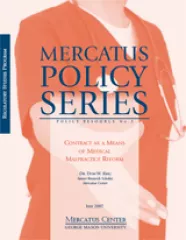- | 2016 Edition: Healthcare Openness and Access Project 2016 Edition: Healthcare Openness and Access Project
- | Healthcare Healthcare
- | Research Papers Research Papers
- |
Medical Liability
The perception of state-level tort risk affects the supply of health care. Perception of risk determines outcomes: businesses and professionals perceive that too many tort claims are being filed and that punitive damages tend to be excessive, and this perception drives the demand for tort reform despite evidence of its minimal overall impact. The presumption that there is a crisis is a driver of supply and investment in health care. State-level tort risk plays a role in many economic decisions, such as where businesses invest and healthcare providers practice, what drugs and medical devices are produced, and which patients receive care.
According to the Congressional Budget Office, in 2000 more than 700,000 tort suits were filed in state courts, compared with 37,000 in federal courts. The National Conference of State Legislatures reported that in 2013, 44 states considered changes to medical malpractice law. The perception of litigation risk has a significant impact on the supply of health care in terms of professional longevity, geographic location, and risk-taking. It also casts a long shadow in the business community. A JAMA study shows that three years after states adopted direct malpractice reforms, the supply of physicians had increased by 3.3 percent.
The actual economic impact of tort reform is difficult to determine, however. Tort reform at the state level is highly diverse, unique, and multilayered, making it difficult to correlate outcome with policy. Overall, the impact of tort reform appears to be extremely limited. For example, in a study of the impact of state tort reforms on physician malpractice payments published in Health Affairs, the authors’ multivariate analysis showed that “strong tort law provisions” explained at most only one-fourth of the variation among states in the average payment amount for a medical malpractice claim, only 1 percent of the variation in the number of claims paid by physicians, and only about 7 percent of the variation in dollars paid per practicing physician for claims.
In the healthcare system, a more important cost driver than actual litigation is physicians’ fear of lawsuits—a fear that gives rise to defensive medicine. According to multiple surveys, a large majority of physicians agree that doctors order more tests and procedures than needed in order to protect against the accusation of negligence and substandard care. According to some estimates, as much as $650 billion to $850 billion is spent annually on defensive medicine.
The HOAP index’s Medical Liability Subindex analyzes three state-level factors: two factors that affect malpractice costs and one composite factor related to reform initiatives. In terms of costs, HOAP (1) assesses the number of malpractice payments per provider for each state and (2) calculates the average cost of malpractice premiums for three practice types (internal medicine, obstetrics and gynecology, and general surgery). In terms of state-level liability reform, HOAP (3) analyzes the presence or absence of 11 major tort reform initiatives in order to generate a composite state score.


